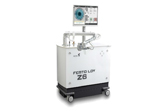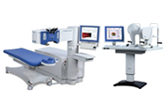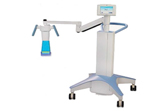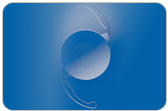Click on the topic of your interest.
FAQs
Is there any preparation required prior to the first consultation?
- If you wear soft lenses it is advisable to stop wearing them for 1 week before the pre-operative consultation but if it is not possible for you to stop wearing them for 1 week then the minimum that you should stop them for is 3 days.
- If you wear hard/ gas permeable lenses it is advisable to stop wearing them for 2 weeks or for a minimum of 1 week prior to the pre-operative consultation.
What range of refractive errors can be treated?
- For Hyperopia the range of error that can be treated is +6.00DS.
- For Myopia the range of error that can be treated is 100- 1500.
- For Astigmatism the range of error that can be treated is -6.00DS.
Can laser vision correction be done if I am pregnant?
- Because there may be some changes in the shape of the cornea or lens during pregnancy as a result of the hormonal changes it is not advisable to have laser vision correction as it will lead to a risk of inaccuracy.
- However you can consider having the surgery 3 months after your delivery and there is no need to be worried about not being able to breast feed after the surgery, it is totally fine.
- Laser vision correction is not known to be harmful to a foetus/ an unborn child.
What are the side effects? Will I go blind if it goes wrong?
- Common side effects are dry eyes, light sensitivity, glare and halos during the first few weeks, but most of these side effects will subside over time.
- Blindness could occur only if a serious complication such as infection or scarring occurs. But this is very rare as antibiotic eye drops are prescribed as a routine to prevent such infections or scarring from occurring.
- EEC’s staff and doctors are highly trained and experienced in LASIK surgery, therefore you will be in very safe hands and even if the worst case of infection occurs, EEC is backed with one of the most experienced cornea surgeon who can treat the patient “Free” to regain eyesight.
How long is the treatment?
• For pre-LASIK Assessment and Surgery to be done on the same day:
• For Assessment and Surgery to be done on different days:
Is it painful?
Local anaesthetic eye drops will be instilled into the eyes throughout the surgery so there is no pain during the procedure, just some pressure is felt at times.
How long does it take to recover?
- For LASIK surgeries, the recovery period would usually take about 24 hours. Most patients will experience better functional vision within this 24 hrs and thereafter their vision will gradually improve over the next few days. That being said, the stability of the vision will vary from person to person, some may take 1 month while others may take up to 3 months for their vision to stabilize.
- For Epi-LASIK surgeries, the recovery period would usually take about 5 days to about 1 week and about 1-3 months for your vision to stabilize.
Can both eyes be operated on at the same time? If not, when can I have the other eye done?
- Yes both eyes can be done on the same day.
- However we can perform the surgery on a separate sitting if you wish. After the first surgery is done, you can do the second surgery the following day or one week later.
- But this is not advised as you may experience giddiness and discomfort due to imbalance of vision during the interim period between the first and second eye. There were concerns regarding the safety of simultaneous LASIK initially but from our experience and from many others’ experiences, it has been shown that simultaneous LASIK does not have significant increase in risk compared to LASIK done on a separate sitting. In fact, simultaneous LASIK offers significant reduction in downtime and convenience.
When can I exercise or swim after the surgery?
In general, normal activities can be resumed after 1 week but please refrain from swimming or water sports for 2 weeks. In addition, for LASIK surgery patients, we would advise you to avoid contact sports for 1 month to avoid accidental injury to the corneal flap.
Can I travel by airplane after the surgery?
Yes you can but preferably travel only at least 5days after your surgery.
How much time off work do I need to take after the surgery? Will medical leave be given?
- For LASIK surgery about 2-3 working days.
- For Epi-LASIK surgery about 5 working days.
- Yes a medical certificate will be given according to the type of surgery that you undergo.
Will my eyes be permanently weakened after the procedure?
- No, LASIK does not weaken your eyes significantly.
- A flap will be present after LASIK is done. But in both LASIK and EpiLASIK, the cornea is thinned down to a safe limit such that long term risks are almost impossible.
What happens if my vision is not fully corrected after the procedure?
- In some cases with undercorrection or overcorrection after the initial laser treatment, enhancement surgery can be performed and this enhancement surgery can be done about 4 months after the LASIK procedure.
- This time interval is to allow stability of the refraction to be achieved before enhancement surgery is performed.
Can I still use spectacles or contact lenses if the treatment does not give satisfactory results?
- Yes, you can still where your spectacles if the treatment doesn’t give you satisfactory results.
- But for contact lenses, it may not be possible to wear soft contact lenses in all cases as the shape of the cornea has been changed by the laser surgery whereas for hard contact lenses, it is can be fitted for all post LASIK cases.
- On the other hand what we can do for you is to plan for an enhancement surgery to help make your vision as satisfactory to you as possible. However, so far our enhancement rate is very low ~1%, hence we don’t ever expect patients to need contact lenses again.
How long will the correction last?
Laser vision correction is permanent. There might be fluctuations in vision in the first 3 to 6 months while the eye is healing but thereafter, the result will be permanent.
How often do I need to come back for post-operative review?
- 1st day post operation
- Within 1st week post operation
- 3 mths post operation
- 6 mths post operation
Can I use Medisave?
No you can’t use your Medisave unless the LASIK surgery was done due to health issues and not for cosmetic purposes.
How do I know if I am suitable for LASIK surgery?
- To determine if you are a suitable LASIK candidate the best method is to make an appointment with us for a thorough pre-LASIK assessment. Without examining your eyes physically, there is no way to tell if you are a suitable candidate for the surgery.
- The general criteria that you must however first fulfil would be that you have to be older than 18, that you are not pregnant, that you have no Cataract, Glaucoma or any retina diseases. Further tests will then be needed to determine degree, cornea shape and thickness for a true LASIK suitability determination.
What if there is a power failure during the surgery?
Not to worry, there is a standalone backup power supply in our clinic which will allow for a safe completion of surgery at any point in time.
Can I see immediately after the surgery? How soon can I see well?
Yes you will be able to see immediately after the surgery but it will be fuzzy. Your vision will gradually improve the day after of which you should then be able to see things more clearly.
Can LASIK surgery treat astigmatism? What about long-sightedness?
- Yes, it can treat astigmatism.
- Yes, it can treat long-sightedness but it depends on individual’s eyes. Also if you have long sightedness with monovision, we do cater for such surgeries too.
What is the difference between LASIK and Epi-LASIK?
- During LASIK surgery a flap is required to be created whereas for Epi-LASIK surgery a flap is not required to be created.
- In addition, for Epi-LASIK surgeries patients may experience slight pain/ discomfort and a slightly slower recovery compared to LASIK surgeries.
- Epi-LASIK is suitable for patients with thin corneas and those active in contact sports.
What is FLEx?
FLEx stands for Femtosecond Lenticule Extraction. It is a all-laser refractive surgery procedure designed for the correction myopia. This is currently believed to be a new alternative to conventional Bladeless LASIK.
In FLEx surgery, a femtosecond laser cuts a lens-shaped layer (a lenticule) from within the cornea. The lens is removed through a LASIK type flap, or removed through a small keyhole incision (Smile), done using one laser.
Is FLEx more superior than Conventional LASIK?
Conventional Bladeless LASIK involves 2 stages – creating a corneal flap with a femtosecond surgical laser, then using an excimer laser to reshape the cornea to treat myopia, hyperopia & astigmatism. The flap is then replaced and allowed to heal.
FLEx is still in its earlier developmental stages so thus it may be too early to compare post outcomes as compared to that for LASIK surgery.
Is the procedure ‘reversible’?
Reversibility of this procedure is highly experimental right now, as repositioning such thin tissues back to the eye is highly likely to induce astigmatism or irregularities. Researchers have not conducted the trials to prove suitability of the re-implantation process for humans so actual success of reversibility cannot be proven as yet.
How does EEC’ss EagleLASIK Technology compare to FLEx?
At EEC, 2 advanced laser technologies are used for the Bladeless LASIK procedure – the Allegretto Wave by Wavelight & the Ziemer’s FEMTO LDV Bladeless Laser.
The FEMTO LDV allows for flap creation and LASIK to be done at the same sitting, meaning that you as a patient, can comfortably lie on one bed without having to move from one machine to another, for the whole procedure. Femtosecond laser allows a more precise creation and evenly shaped cornea flap which gives a more uniform surface for the excimer laser treatment. The pulse energies are low, and the delivery optics are very tightly focused for maximum tissue disruption. This allows a faster healing and visual recovery time than any other technology in the world.
The Allegretto Wave Light laser machine has the distinction of having the fastest laser system in the world that can perform vision correction in the shortest time, reducing risks of inaccuracies from drying up of cornea tissue and providing consistently accurate results. The machine is efficient in using small amounts of cornea tissue to provide maximum amount of correction without damaging adjacent stroma tissue.
At EEC 99% of our LASIK patients of all degrees achieved 6/12 or better vision. Less than 1% of the patients require retreatment.
** EEC performs an average of more than 2000 lasik surgeries a year
Premium EagleLASIK Technology
EEC is committed to stay at the forefront of LASIK technology to serve our patients better.
• outcomes
• Increased sensitivity to eye movements
• Reduced corneal complications
• Reduced patient fatigue
• Better LASIK flaps
• Improved centration
• Corneal transplantation capability
• Able to assist in Cataract surgery
• Maximum comfort
• Reduced re-treatments
• Minimised corneal collateral damage
• Optimal eye trackingThe Schwind CAM Schwind CAM is a diagnostic system which provides an extensive array of measuring methods for refractive and therapeutic corneal surgery. Its intelligent planning tool allow for extensive and customized refractive laser treatment.Whether aberration-free or customized treatments, aspheric ablation profiles are used, based on corneal wavefront data. These minimize the induction of aberrations and ensure excellent contrast sensitivity.
• New flap options
• Improved stability
• Smoother flap separation
• Reduced inflammation
Singapore’s Representative Clinic selected to conduct Phase 4 Clinical Trials on the latest Multifocal Lens Implant
Patient visit on monthly basis from 2007-2011
Locate us
820 Thomson Road,
Mount Alvernia Hospital,
Medical Centre D, #06-57/58/59/60/61/62
Singapore 574623
Mount Elizabeth Medical Centre,
3 Mount Elizabeth #08-08,
Singapore 228510
Parkway East Medical Centre,
319 Joo Chiat Place,
#05-03 Singapore 427989
38 Irawaddy Road,
Mount Elizabeth Novena Specialist Centre,
#08-22/23/24 Singapore 329563
Westgate Mall,
3 Gateway Drive,
#02-42A Singapore 608532
Royal Square Novena Medical Centre at Royal Square at Novena,
101 Irrawaddy Road,
#11-07 to 13 Singapore 329565
KAP Residences Mall,
9 King Albert Park,
#01-42/43/44 Singapore 598332
12 Farrer Park Station Road,
#05-02/03/04,
StarMed Specialist Centre, Singapore 217565







